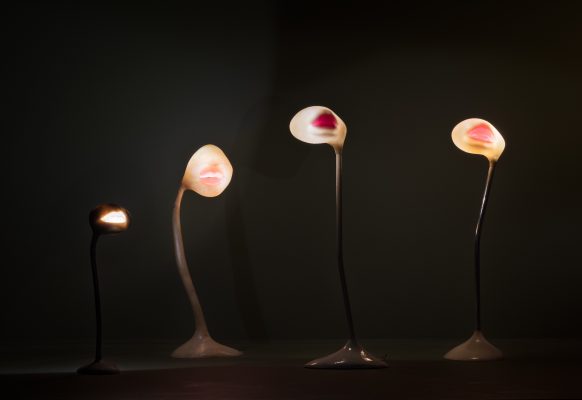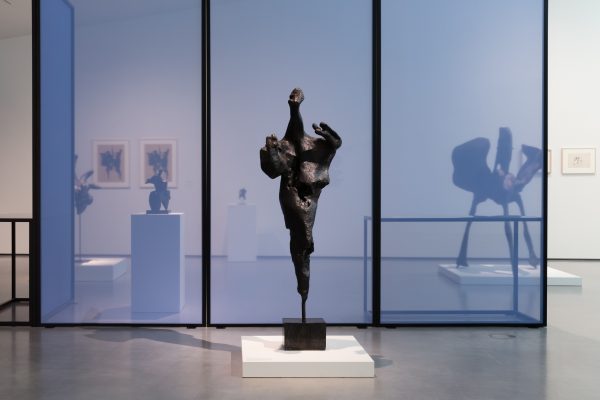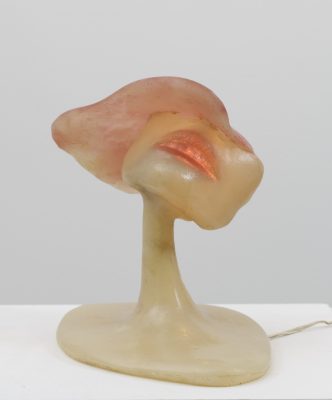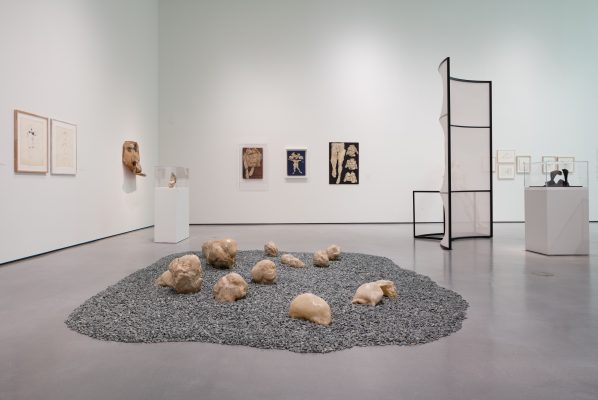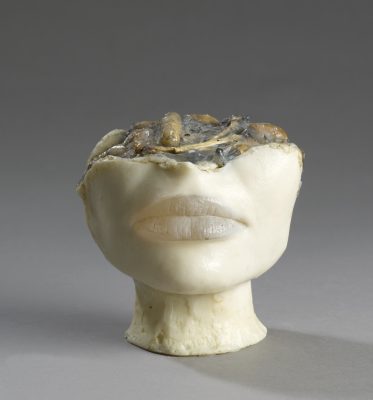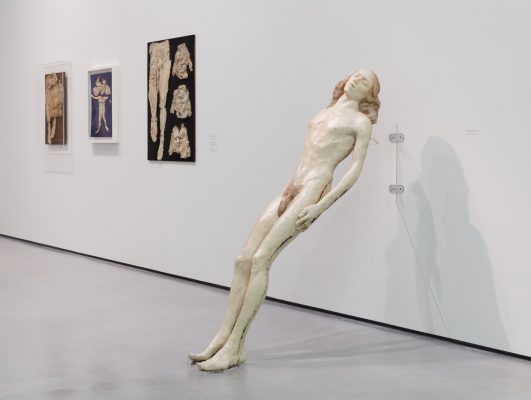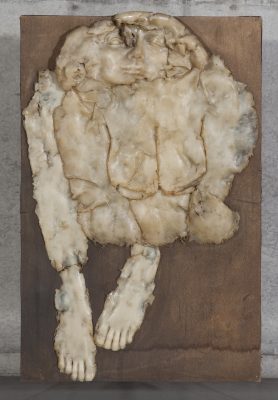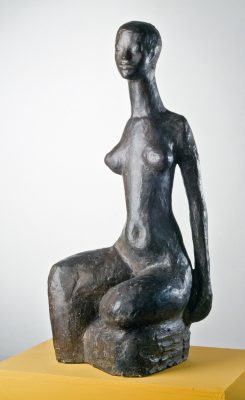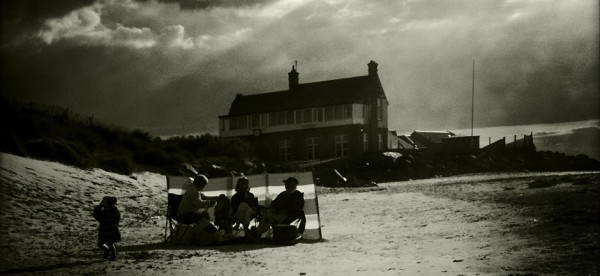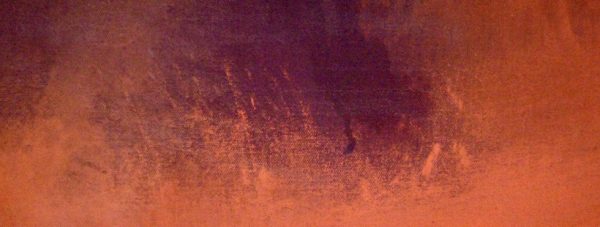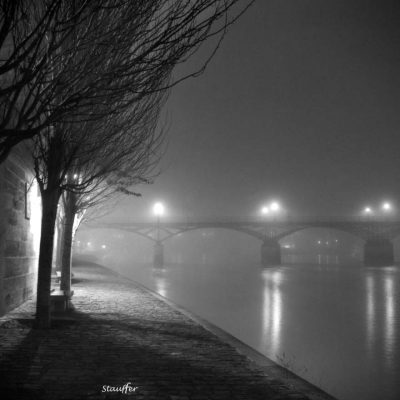‘I produce awkward objects,’ the sculptor Alina Szapocznikow wrote in 1972. ‘Of all the manifestations of the ephemeral, the human body is the most vulnerable, the only source of all joy, all suffering and all truth.’ Awkward, precarious, vulnerable bodies are as crucial to an understanding of Szapocznikow’s oeuvre as they are to her biography. As a result, her life and work are often viewed as inseparable, a conflation that poses an interesting predicament regarding the extent to which one should read an artist’s work through the lens of their personal experience.
Born into a Jewish intellectual family in Kalisz, Poland in 1926, Szapocznikow was ghettoised by the Nazis during her teenage years, and sent to concentration camps including Bergen-Belsen and Auschwitz. After the war, she trained as a sculptor in both Prague and Paris, and returned to Poland in 1951, where she produced a number of large-scale public commissions and exhibitions, including The Climbing (1959), a monument to those who died in the 1943 Warsaw Ghetto Uprising. In 1963, she moved back to Paris, where she remained until her death from breast cancer in 1973, aged 46.
Despite having been an influential and well-known artist in Poland since the 1950s, until relatively recently Szapocznikow has remained internationally obscure. The trajectory of her marginalisation and rehabilitation is familiar: the double bind of being both Polish and a woman meant she was overlooked by the Western and male-centric gatekeepers of art history, only to be celebrated post mortem. Like many women artists who have died young or suffered unfortunate circumstances, such as Ana Mendieta or Francesca Woodman, there is a tendency to view Szapocznikow’s work through her life story, so that her sculptures and drawings become illustrations of this history. Her experiences of war and proximity to death undoubtedly influenced her work – and are hard, if not impossible, to untangle from it. But to focus solely on biography runs the risk of disregarding her involvement with avant-garde developments: the expansion of sculpture as a non-figurative form, the unconventional use of construction materials (cement, latex, polyester resin, and polyurethane foam), and an interest in the physical and psychic properties of fragility, decay, and transience.
Szapocznikow deliberately selected volatile and perishable materials that would continue to degrade over time. This makes the retrospective ‘Alina Szapocznikow: Human Landscapes’ at The Hepworth Wakefield something of a coup. It is the first major exhibition of Szapocznikow’s work in the UK, and, along with exhibiting a significant selection of drawings rarely seen in public before, a proportion of the artworks on show may not be able to travel again, once returned to their owners. Among a number of visibly fragile works is a series of large, unstable sculptures in which Nazi weaponry, artillery shells, car parts, and other industrial objects have been embedded into concrete before it has hardened.
Much of Szapocznikow’s recent critical revival is due to the work of the Museum of Modern Art in Warsaw. In 2009, they hosted the exhibition ‘Awkward Objects’, showing her work alongside that of Maria Bartuszova, Pauline Boty, Louise Bourgeois, and Eva Hesse – artists who, like Szapocznikow, are no strangers to underappreciation – in an attempt to explicate the relationships between their unorthodox uses of materials. At an accompanying conference it was proposed that the audience ‘listen’ directly to Szapocznikow’s work itself, eschewing her biography in order to explore its multifarious resonances. Elena Filipovic and Joanna Mytkowska, the curators of Szapocznikow’s first international survey, ‘Alina Szapocznikow: Sculpture Undone’ (2012-13), at New York’s MoMA, sought to do the same, criticising previous ‘biographical determinism’. They agreed that the popular narrative, which ‘disproportionately focused on the trauma of her concentration-camp experiences, recurrent ill health, and premature death’, meant that Szapocznikow and her work ‘had suffered posthumously from a foreclosure of meaning.’[1] Anne Wagner has explored a similar issue with regards to the obsessive focus on Eva Hesse’s biography when interpreting her work, which she conceptualises as ‘Hesse as wound’. ‘Much of the writing about the artist cannot resist taking advantage of the free mileage it gets from Hesse’s early death,’ Wagner wrote in an essay published in October in 1994. ‘When it is harnessed to her troubled life, so called, an irresistible package results.’[2]
A significant proportion of ‘Alina Szapocznikow: Human Landscapes’ focuses on a series of sculptures centred on lips and breasts produced in the 1960s, which combine experiments in casting and modelling with the use of bright polyester resins. Szapocznikow concealed light bulbs in many of these works, transforming them into functional desk lamps, as in the series Illuminated Lips (1966), in which the stand appears like a sinuous, stretched stem, buckling under the weight of a lip-shaped globule. As with later versions also on show, such as Sculpture-Lamp (1970), the resin surrounding the bulbs appears almost rococo – melted, thick, shell-like canopies, cast in hues of pink and beige. Szapocznikow described the manner in which her interest in the lamp-form was piqued by its relationship to consumer culture and modular reproduction, and here, repetition becomes darkly fetishistic. These sculptures are full of a latent unease at the reduction of women’s bodies to sexualised household objects, a sentiment echoed by many of the works on display – among which the sludge-like cigarette butts preserved in the broken crown of a woman’s head in The Bachelor’s Ashtray I (1972) is particularly disturbing.
Dismembered and distorted body parts started to appear in Szapocznikow’s work from the late 1950s onwards. The first room of the exhibition, which focuses on her early work, includes the sculptures First Love (1954) and Difficult Age (1956) – two female bodies in the Soviet-Realist style, with elongated torsos, strong taut limbs and valiant postures, made from plastic, cement and bronze. In a larger bronze, Maria Magdalena (1957), Szapocznikow begins to exaggerate and subvert the body, fusing it with supple, amorphous planes. This move towards a more visceral mode of expression is mirrored by the rapidly produced drawings she made during the 1950s and 1960s, of disembodied limb-and-organ-like shapes. In the series Desserts (1970-71), soft breasts appear in glass dessert bowls, like scoops of ice cream or thawing blocks of ice, their waxy material seeping over the sides.
Productive parallels can be drawn between Szapocznikow’s warped body parts and Paul Thek’s wax effigies and melting hunks of meat, Tetsumi Kudo’s surreal lurid assemblages, and Lynda Benglis’s oozing latex. Like Szapocznikow, these artists offer a riposte to clean, commercial Pop, the industrial, anti-emotional language of Minimalism, and the analytical immateriality of Conceptual art, and help to locate her work outside the genre of ‘wounded woman’. A year into her cancer diagnosis, Szapocznikow began to confront the means of her own death more directly, producing works from which it is much harder to eschew the role of biography, as Filipovic, Mytkowska, and the curators of MoMA Warsaw ask. Bulbous masses proliferated in her drawings from late 1968 through her death in 1973, in the form of strange, cellular interlocking arrangements. In the 14-part sculpture Tumours Personified (1971), these protuberant configurations were realised three-dimensionally, in polyester, wool, paper and gauze; in Fetish IX (1970), a disembodied breast is shrouded in a solidified bundle of gauze, as if discarded.
At the very end of her life, Szapocznikow focused on two major projects: the Herbarium series (1971-2) and a life-sized polyester cast of her son, Piotr (1972). For Herbarium, Szapocznikow made latex casts of her and Piotr’s bodies, flattening them when they were still soft so that they became almost two-dimensional, and then affixing them to wooden boards. There is something surreal, macabre, and deeply tragic about their presence, pressed like Victorian flowers but with the appearance of flayed meat. As with all of Szapocznikow’s work, the body is both hers and not hers – an artistic invention, a material experiment, and a record of a passing, and sometimes painful, life.
[1] Elena Filipovic and Joanna Mytkowska, ‘Introduction,’ in ‘Alina Szapocznikow: Sculpture Undone 1955-1972’, The Museum of Modern Art, New York, 2012, p 10
[2] Anne M Wagner, ‘Another Hesse,’ in October, Vol 69, Summer 1994, pp 54-55
